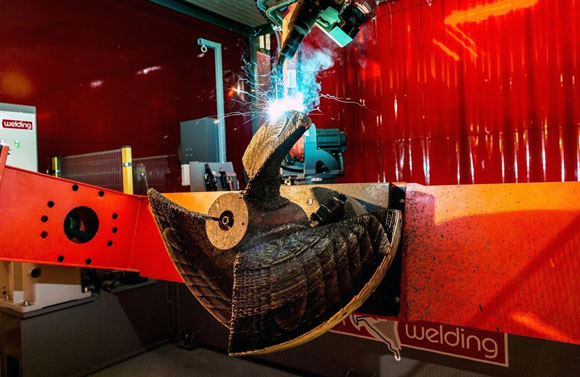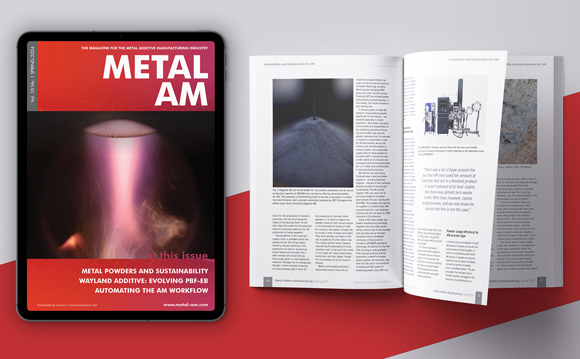World’s first metal additively manufactured ship propeller nears completion
September 18, 2017

WAAMpeller prototype during production (Courtesy Damen)
Rotterdam Additive Manufacturing Lab (RAMLAB), Rotterdam, the Netherlands, has produced a full-scale prototype of the world’s first class approved metal additively manufactured ship’s propeller. The propeller is being developed by a consortium of companies including Damen Shipyards Group, RAMLAB, Promarin, Autodesk and Bureau Veritas.
The 1,350 mm diameter, 400 kg triple-bladed propeller – named WAAMpeller - is based on a Promarin design used on Damen’s Stan Tug 1606. It is produced in a Nickel Aluminium Bronze (NAB) alloy using a hybrid manufacturing process combining wire and arc Additive Manufacturing using industrial robotic arms, followed by CNC milling at Autodesk’s Advanced Manufacturing Facility in Birmingham, UK.
This first prototype WAAMpeller will be used for display purposes, and planning for a second example is already underway. The consortium reports that it will begin production of a second class approved propeller prototype late in October 2017, with the aim of installing it on a working tug by the end of the year.
Currently, if a vessel comes into port needing a replacement part such as a propeller, it can take weeks or months to order and deliver, costing companies millions of dollars in time. It can also be quite costly for companies to keep large stockpiles of parts in warehouses around the globe.
Using faster fabrication options such as the metal AM of large ship components and finishing the pieces using traditional CNC milling and grinding methods, replacement parts could be produced within a matter of days, saving time and money without sacrificing precision or performance.
According to Damen, one of the key challenges in the propeller’s development has been understanding its materials properties. “3D printed materials are built up layer by layer,” explains Kees Custers, Project Engineer in Damen’s R&D department. “As a consequence, they display different physical properties in different directions – a characteristic known as anisotropy. Steel or cast materials, on the other hand, are isotropic – they have the same properties in all directions.”
One of the first steps the development team took was to carry out extensive testing of the material properties of the printed material to ensure compliance to Bureau Veritas standards. “This involved printing two straightforward walls of material,” states Custers, “then using a milling machine to produce samples for lab testing of tensile and static strengths.”
Another key challenge was in redesigning the propeller for Additive Manufacturing. “The challenge has been to translate a 3D CAD file on a computer into a physical product. This is made more complex because this propeller is a double-curved, geometric shape with some tricky overhanging sections,” Custers explains.
“We have to make sure that the material properties meet the needs of the application,” states Wei Ya, Postdoctoral Researcher from the University of Twente at RAMLAB. “Material toughness, for example – ensuring that the propeller is able to absorb significant impact without damage. But we have also been working towards optimising the production strategy for 3D metal deposition. This includes bead shape and width, as well as how fast we can deposit the printed material.”
By taking advantage of RAMLAB’s ability to additively manufacture objects with maximum dimensions of 7 x 2 x 2 m, the consortium was able to print the metal AM propeller to scale. “For large scale 3D metal deposition, the WAAMpeller is really ground-breaking for the maritime industry,” Ya concludes.
“This technology is a fundamental change in the concept of how we make things. With Additive Manufacturing, you can print most metallic components that are needed in principle. There is so much potential for the future – these techniques will have a big impact on the supply chain.”
















